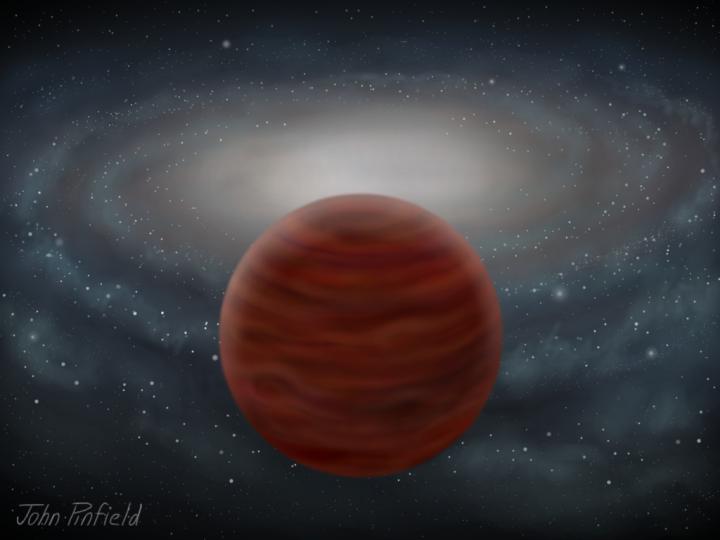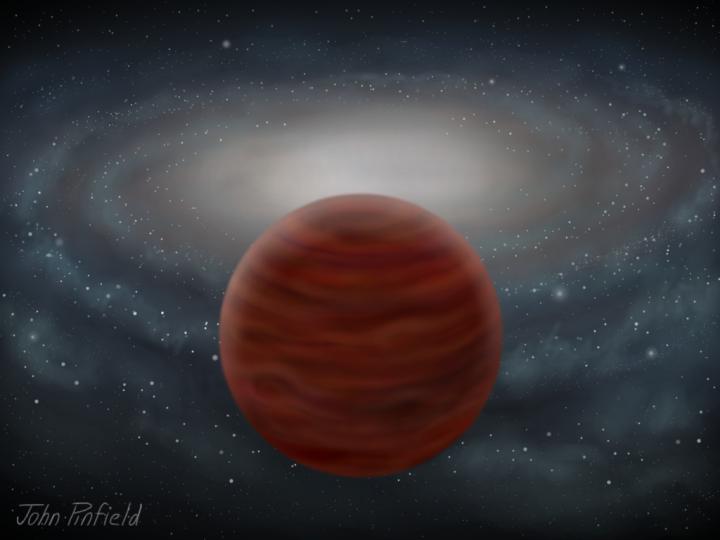
Credit: John Pinfield
An international team of astronomers has identified a record breaking brown dwarf (a star too small for nuclear fusion) with the 'purest' composition and the highest mass yet known. The object, known as SDSS J0104+1535, is a member of the so-called halo – the outermost reaches – of our Galaxy, made up of the most ancient stars. The scientists report the discovery in Monthly Notices of the Royal Astronomical Society.
Brown dwarfs are intermediate between planets and fully-fledged stars. Their mass is too small for full nuclear fusion of hydrogen to helium (with a consequent release of energy) to take place, but they are usually significantly more massive than planets.
Located 750 light years away in the constellation of Pisces, SDSS J0104+1535 is made of gas that is around 250 times purer than the Sun, so consists of more than 99.99% hydrogen and helium. Estimated to have formed about 10 billion years ago, measurements also suggest it has a mass equivalent to 90 times that of Jupiter, making it the most massive brown dwarf found to date.
It was previously not known if brown dwarfs could form from such primordial gas, and the discovery points the way to a larger undiscovered population of extremely pure brown dwarfs from our Galaxy's ancient past.
The research team was led by Dr ZengHua Zhang of the Institute of Astrophysics in the Canary Islands. He said: "We really didn't expect to see brown dwarfs that are this pure. Having found one though often suggests a much larger hitherto undiscovered population – I'd be very surprised if there aren't many more similar objects out there waiting to be found."
SDSS J0104+1535 has been classified as an L type ultra-subdwarf using its optical and near-infrared spectrum, measured using the European Southern Observatory's "Very Large Telescope" (VLT). This classification was based on a scheme very recently established by Dr Zhang.
###
Media contacts
Dr Robert Massey
Royal Astronomical Society
Tel: +44 (0)20 7292 3979
Mob: +44 (0)7802 877 699
[email protected]
Dr Morgan Hollis
Royal Astronomical Society
Tel: +44 (0)20 7292 3977
[email protected]
Science contacts
Dr ZengHua Zhang
Instituto de Astrofísica de Canarias,
E-38205 La Laguna, Tenerife, Spain
[email protected]
Prof David Pinfield
Centre for Astrophysics Research, University of Hertfordshire,
Hatfield AL10 9AB, UK
[email protected]
Image and caption
https://www.ras.org.uk/images/stories/press/Brown_Dwarf/halo_brown_dwarf.jpeg
An artist's impression of the new pure and massive brown dwarf. Credit: John Pinfield
Further information
The new work appears in "Primeval very low-mass stars and brown dwarfs – II. The most metal-poor substellar object", Z. H. Zhang, D. Homeier, D. J. Pinfield, N. Lodieu, H. R. A. Jones, F. Allard, and Ya. V. Pavlenko, Monthly Notices of the Royal Astronomical Society, published by Oxford University Press, in press. A copy of the paper is available from http://doi.org/10.1093/mnras/stx350
A preprint can be found on the arXiv at https://arxiv.org/abs/1702.02001
Notes for editors
The Royal Astronomical Society (RAS, http://www.ras.org.uk), founded in 1820, encourages and promotes the study of astronomy, solar-system science, geophysics and closely related branches of science. The RAS organizes scientific meetings, publishes international research and review journals, recognizes outstanding achievements by the award of medals and prizes, maintains an extensive library, supports education through grants and outreach activities and represents UK astronomy nationally and internationally. Its more than 4,000 members (Fellows), a third based overseas, include scientific researchers in universities, observatories and laboratories as well as historians of astronomy and others.
The RAS accepts papers for its journals based on the principle of peer review, in which fellow experts on the editorial boards accept the paper as worth considering. The Society issues press releases based on a similar principle, but the organisations and scientists concerned have overall responsibility for their content.
T: https://twitter.com/royalastrosoc
F: https://www.facebook.com/RoyalAstroSoc/
Media Contact
Dr. Robert Massey
[email protected]
020-729-23979
http://www.ras.org.uk/ras
############
Story Source: Materials provided by Scienmag





